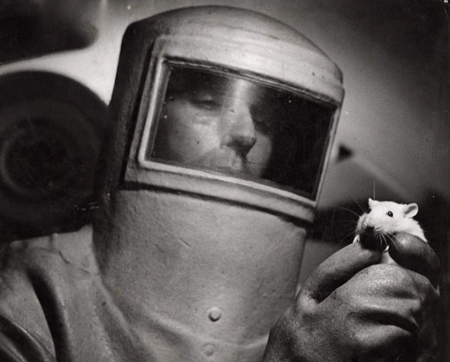A Strange New Laboratory
Scientists were curious whether germ-free organisms would live longer, and planned to study cancer, heart disease, tooth decay, and more.That first germ-free laboratory was a marvel, but it was beyond the capabilities of most research institutions to replicate. Advances in technology enabled broader access to germ-free facilities in a variety of research disciplines. Today, most germ-free mice are typically raised in flexible film or semi-rigid isolators, or managed in individually ventilated cages for short term studies.

W. Eugene Smith, [Man in protective helmet and rubber gloves holding mouse, Laboratories of Bacteriology at the University of Notre Dame, Indiana], 1949 (1519.2005)
Evolution of Germ-Free Research
In the early years of germ-free animal model research, nutrition, infectious disease and dental disease were the most common applications. Immunology researchers in the 1980s studied differences in immune response of germ-free mice, as well as allergy and antibody development, and adapting animals with human flora.These lines of investigation lead researchers to the roles of microbiota in development, immune response, and protection from diseases ranging from cancer to diabetes to rheumatoid arthritis.
The Future of Germ-Free Model Research
Germ-free mice are a key to elucidating the role of the microbiome in disease. Researchers found that bacterial communities of the gut flora can protect from obesity or food allergies, whereas presence of others can lead to chronic inflammation and related conditions such as Crohn's disease, non-alcoholic fatty liver disease, and rheumatoid arthritis. The intestinal microbiome is emerging as a causative or protective factor in a surprising number of diseases, ranging from depression to diabetes, even cancer and autoimmune diseases.Custom flora associations allow scientists to better understand the role of the microbiome in disease development and progression, leading to novel therapeutic discoveries. With the advent of personalized medicine, germ-free mice may be used to more effectively model individual human disease states.
Those first researchers, over sixty years ago, could not have imagined today's applications for germ-free mice and animal models. Perhaps sixty years from now, we will be equally amazed.
















.jpg)

.jpg)
.jpg)
.jpg)
.jpg)





.jpg)


.jpg)
.jpg)




.jpg)




.jpg)

.jpg)




